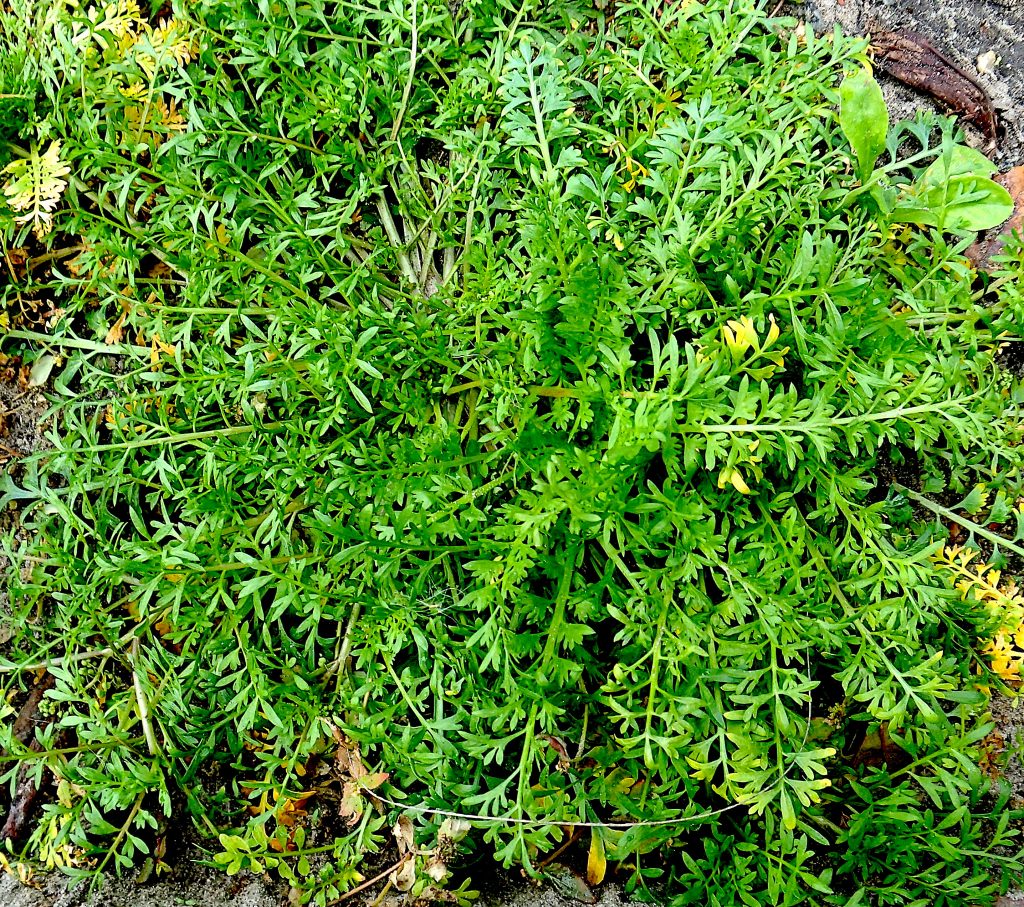
From not far above Swinecress can appear feathery. Photo by Green Deane
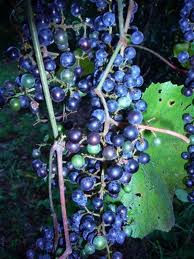
Florida’s bunch grapes. Photo by Green Deane
Mother Nature can be fickle and it’s almost always tied to weather. Twice this week we saw where she defied the seasons. First it was grapes. Whether single- or forked-tendriled their season locally is the last half of August or the first half of September, much the same as in Maine where I grew up. This can move a few weeks either way though I have also seen them as early as late July. But, if one starts looking for grapes in mid-August you usually won’t miss them. This week we saw ripe single-tendril cluster grapes in Ft. Pierce. That’s a couple of months out of season so you never know. You can read about wild grapes here or see a video on them here.
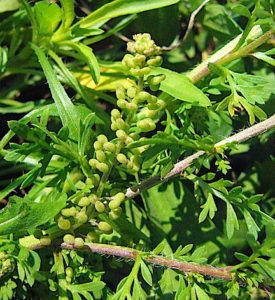
Swinecress’ seeds are distinctive. Photo by Green Deane
Almost as surprising was Swinecress in Sarasota (see main photo above and left.) I look for this mustard relative in lawns usually after the New Year. More so the specimen we saw — growing at the base of a stop sign — was old enough to have seeds so it’s been around for a few weeks or a month. There are a couple of notable aspects to Swinecress. One is that it’s flavor grows in intensity as you eat it. It begins mild. The other is that once it is seeding it’s nearly impossible to misidentify. From a flavor point of view it would make a good commercial crop but it’s usually a low grower and relatively small compared to other winter greens. I think it would be a fine plant for the home winter garden, however. You can read about “naughty” Swinecress here.
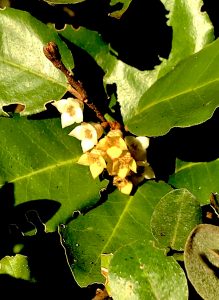
Silverthorn in blossom in December. Photo by Green Deane
As if on cue we also saw in Sarasota Silverthorn in blossom. It’s one of the few fruits that sets in our winter and is usually ripe about Valentine’s Day. That’s handy because the jelly-bean sized fruit is red with a gold netting or spray on it. But, if you remember the red fruit is ready around Valentine’s Day you’ll be looking for it. Right now the boxy blossoms help you identify which shrubs will be producing fruit this year. It’s a common landscape plant and also an escapee. New fruit likes to grow on new growth and with waxy leave the species is fairly easy to identify. Even though the fruit is small it has the distinction of having the highest amount of the antioxidant lycopene per weight of any fruit. You can read about Silverthorn here and watch a video here.
Foraging classes this week are, for me, out of town and local. Saturday we’re in Largo where there is a threat of rain but a good temperature. Sunday I’m back in Orlando for what should be a sunny, pleasant day.
Saturday, December 14th, Eagle Park Lake, 1800 Keene Road, Largo, FL 33771. Meet at the pavilion near the dog park. 9 a.m. to noon.
Sunday, December 15th, Blanchard Park, 10501 Jay Blanchard Trail, Orlando, FL 32817. Meet at the picnic area east of the tennis courts. 9 a.m to noon.
Sunday December 22nd, Ft. Meade Outdoor Recreation Area, 1639 Frostproof Highway, Fort Meade, FL 33841. (Frostproof Highway is also Route 98.) 9 a.m to noon. Meet at the second set of bathrooms (in the middle of the park) which is due south from the highway. (Note that is Ft. Meade, not Mead Gardens.)
Saturday December 28th, Bayshore Live Oak Park, Bayshore Drive. Port Charlotte. Meet at the parking lot at the intersection of Bayshore Road and Ganyard Street. 9 a.m. to noon.
Sunday, January 5th, Dreher Park, 1200 Southern Blvd., West Palm Beach, 33405. Meet just north of the science center. 9 a.m. to noon.
To learn more about the classes, to sign up for a class, or to pre-pay for a class go here.
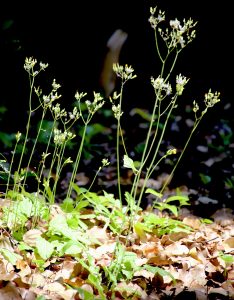
False Hawk’s Beard is more spindly than Dandelions. Photo by Green Deane
Another cool weather plant we saw is False Hawk’s Beard, Crepis japonica. It’s a fairly common edible and is not too particular where it grows. You can find it in your lawn, garden, or in sidewalk cracks. It’s a favorite pot herb. Non-native, False Hawk’s Beard is a distant Asian relative of the Dandelion. Unlike the Dandelion it has multiple blossoms and no white sap. There are quite a few different species in the genus and they are all reportedly edible. Thus, if there is a Crepis near you there’s always something to forage for. Fairly easy to identify and of good taste they seem to get left out of most foraging books even though they are naturalized across. To see a video about False Hawk’s beard go here. To read about the False Hawk’s Beard go here.
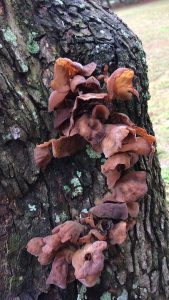
Jelly Ear fungus at Sandlando Park. Photo by Green Deane
The number of edible mushrooms this time of year drops off to mostly those found growing on wood: Chicken of the Woods, Oysters, Lion’s Mane, and Deer Mushrooms. One that gets short-changed some is Jelly Ears, Auricularia. Why are they overlooked? Being flavorless is probably one good reason and they are not the prettiest of mushrooms either. Identification of the exact species can be a bit trying as well. So why eat them? One reason is their survival mechanism: They dry up in dry times then rehydrate in wet times. So you can dry them then soak them in flavorful liquids to deliver chosen flavor and enhance dishes. They are fairly common in Asian cuisine. Further research in 2015 showed a crude polysaccharide extract of Auricularia auricular-judae “had great antimicrobial activities against Escherichia coli and Staphylococcus aureus.” Also the mushroom itself “had significant antioxidant activities in scavenging free radicals.” Tasty food and medicine. Not bad for an ugly mushroom that likes hardwood trees.
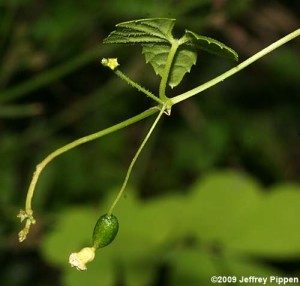
Creeping Cucumber keeps fruiting until really cold weather.
Botany Builder #31: Pendulous, hanging loosely or swinging freely, from the Dead Latin pendo, to hang down. Adjective forms can also be “pensile” and “pendant.” One local edible that has this word form in its name is Melothria Pendula, or the Creeping Cucumber aka Mouse Cucumber. The species has a two-inch or longer stem then a jelly-bean sized cuke on the end. They are very tasty and edible when light to medium green. Darker colors should be avoided. We saw a lot of them in Ft. Pierce this past weekend. To read more about the Melothria pendula go here.
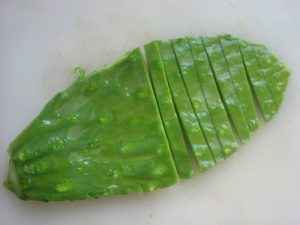
Make sure you remove all the glochids. Photo by Green Deane
How to pick a cactus pad. In a word carefully. Most foragers know cactus have edible parts but what does one look for, generally? First make sure it’s a pad, segmented often oval or tear-drop shaped. You do not want anything that looks serpentine. Also no white sap. White sap in plants that resemble cactus can be very deadly even after being dry many years. In one case smoke from burning desiccated Euphobia branches killed some stranded people. They were trying to stay warm around the fire on a cold desert night. So, pads, no white sap. While which cactus you collect (Opuntia or Nopales) might be the luck of the draw, the less spines the better, and the less glochids the much better. Glochids are tiny tuffs of sharp hair that hurt, are hard to dig out, and last for days. Ma Natures knows the pads are good food so she protects them mightily. Big spines can be cut, burned or scraped off, glochids burned or washed off. Just scraping is not so successful with glochids. Wear stiff gloves without seams. Those little glochids will pass right through seams and get ya. Hint: Young pads, the ones we want anyway, often have not developed glochids yet.
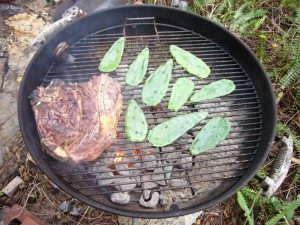
Nopales on the grill. Photo by Green Deane
Let us presume you have a spineless, glochidless young pad. What do you do with it? You can eat it raw, skin and all, or roast it or boil it. I know one restuarant that steams them (preserving color) then lightly grills them puting the pads whole on a Mexicanesque hamburgers. With older (de-spined) pads you can still eat them raw or cook. Usually the tougher spine “eyes” are removed just like you would with a potato. And the pad can be peeled as well. Pads at a certain point become woody and too tough to eat. To see a video on cactus go here, here and here. To read more about cactus click here.
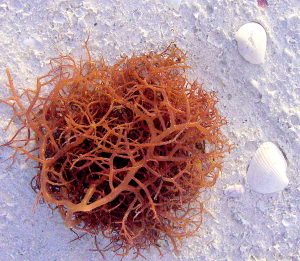
What seaweed is it? Photo by Green Deane
Want to identify a plant? Perhaps you’re looking for a foraging reference? You might have a UFO, an Unidentified Flowering Object, you want identified. On the Green Deane Forum we — including Green Deane and others from around the world — chat about foraging all year. And it’s not just about warm-weather plants or just North American flora. Many nations share common weeds so there’s a lot to talk about, such as the one to the left. There’s also more than weeds. The reference section has information for foraging around the world. There are also articles on food preservation, and forgotten skills from making bows to fermenting food. Recent topics include: Asystasia gangetica aka Chinese Violet or Ganges Primrose, Armillaria mellea Ringed Honeys, Acorn Treatment Question, Acorn Questions Any Poisons? A Cure For The Common Cold, Lactifluus piperatus, Elderberry Capers? You can join the forum by clicking on the button on the upper right hand side of this page.

The Nine DVD set includes 135 videos.
Though your foraging may drop off during the winter it’s a great time to study wild edibles with my nine DVD set. Each DVDs has 15 videos for 135 in all. They make a great Christmas gift. Order today. Some of these videos are of better quality than my free ones on the Internet. They are the same videos but many people like to have their own copy. I burn and compile the sets myself so if you have any issues I handle them personally. There are no middle foragers. And I’m working on adding a tenth DVD. To learn more about the DVDs or to order them click here.
 Donations to upgrade EatTheWeeds.com have gone well. Thank you to all who have contributed to either via the Go Fund Me link, the PayPal donation link or by writing to Green Deane POB 941793 Maitland FL, 32794. There are many needs left such as expanding the foraging teacher page, the page on monotypic edibles and the Plant Archive page. There’s always something and such things get more complex and expensive every year.
Donations to upgrade EatTheWeeds.com have gone well. Thank you to all who have contributed to either via the Go Fund Me link, the PayPal donation link or by writing to Green Deane POB 941793 Maitland FL, 32794. There are many needs left such as expanding the foraging teacher page, the page on monotypic edibles and the Plant Archive page. There’s always something and such things get more complex and expensive every year.
This is weekly newsletter 383. If you want to subscribe to this free newsletter you can find the sign-up form in the menu at the top of the page.
To donate to the Green Deane Newsletter click here.


I always find your information very interesting, but plants like Silverthorn, Elaeagnus pungens, which may be edible is also a category II invasive in north and central Florida per FLEPPC and therefore should not be grown in those parts of Florida and needs to be removed from parks and preserves and wetlands. So, don’t just eat the fruit. Take out the whole plant to keep them from out competing the native plants that are needed.
Just a reminder to all to taste very small amounts initially, and then you should probably have an antihistamine tablet or two handy. Another author had mentioned Canna roots as edible. I had been growing them in 3 children’s wading pools for several years and determined to try them recently. I took a very small section to clean and chew. They are supposed to be sweet but fibrous, one is supposed to suck and swallow then spit out the fibers. First thing I noticed was it wasn’t sweet (yes, it was definitely a canna that had recently flowered) Then my mouth and nose flooded with saliva and mucous. It wasn’t a reaction to pesticides or fertilizer- who has time for all that nonsense? I ran for the house and first gargled with peroxide and rinsed and spat a lot. Then I took some antihistamines. (about double the usual dose) So please be careful when attempting initial trials of edible plants!